De onverwachtse voordelen van Zero-tolerance

Johan SANCTORUM
Ex: http://visionairbelgie.wordpress.com/
Zopas liep ik nog eens tegen de lamp met een parkeerovertreding: schijf vergeten te plaatsen. Vergeten, nu ja, ik moet bekennen dat ik er ook geen zin in had. Of als ik nog eerlijker moet zijn: misschien vond ik het zelfs opwindend om die parkeerschijf niet te plaatsen, en het vervolg van het verhaal af te wachten.
Meteen een ideaal aanknopingspunt om eens door te bomen over het doolhof van regels, reglementen en wetten waarin wij leven en sterven,- en over de psychologie van macht en (on)gehoorzaamheid. Duwen we op het gaspedaal om sneller ter bestemming te zijn, of is het de libertijn in ons die wakker wordt? Plassen we wild omdat de nood zo hoog is, of ook wel net omdat het niet mag? Ontduiken we belastingen om rijker (of minder arm) te worden, of uit rebellie tegen het systeem? Of… gewoon voor de fun? Hebben wij regels nodig, om ze te kunnen negeren? En waar komt dat plezier in de ongehoorzaamheid vandaan?
Jantje en de pruimen
Zeer tegen de zin van de postmoderne inquisitie die gaandeweg de universiteiten controleert, en het vooral op Freud, Lacan en de psychoanalyse heeft gemunt, – maar eigenlijk op elke vorm van speculatief denken-, zal ik nog eens een neo-Freudiaanse piste bewandelen over de intense samenhang tussen verbod en genot, gevaar en lust. Het ene roept namelijk het andere op.
Stel u een universum voor waar alles toegelaten zou zijn, zonder enige controle, straf of consequentie: we zouden vergaan van verveling. Dus worden er grenzen afgetast. Eerst is er de zindelijkheidstraining die maar niet wil lukken. Daarna het stiekem snoepen. Boeren aan tafel, de verkeerde hand geven, foute boekjes lezen. Spookrijden, verboden websites bezoeken. Hoe meer flitspalen, des te sterker proberen we ze te ontwijken. Het zebrapad is veilig, maar de ruimte ernaast veel aantrekkelijker. Het rood licht zegt stop, maar iets in ons zegt: “doorgaan”. De moraal en het fatsoen wijzen de weg naar de overkant. Stoute jongens en nieuwsgierige meisjes worden, net langsheen het pad van de deugdzaamheid, geprikkeld om zijwegen in te slaan en no-go-zones te exploreren.
Ik vermoed dat zo’n 80% van ons bewustzijn zich, dag-in-dag-uit, met die grijze zone bezig houdt: wat zijn de regels, hoe groot is de verleiding om ze ontwijken, wat zijn de voordelen ervan, wat is het betrappingsrisico, hoe ziet de sanctie eruit. De criminologie is de moeder van alle menswetenschappen. De moraal de schoonmoeder.
In onze taal is het inzicht, dat er een pad loopt van het verbod naar het verlangen, gemeengoed geworden dankzij het overbekende vers van Hiëronymus van Alphen, een 19de eeuwse advocaat uit Gouda:
Jantje zag eens pruimen hangen,O! als eieren zo groot. ’t Scheen, dat Jantje ze wou gaan plukken, Schoon zijn vader ‘t hem verbood. Hier is, zei hij, noch mijn vader, Noch de tuinman, die het ziet: Aan een boom, zo vol geladen, Mist men vijf, zes pruimen niet. Maar ik wil gehoorzaam wezen, En niet plukken; ik loop heen. Zou ik om een hand vol pruimen Ongehoorzaam wezen? Neen !Een Tantalus-ervaring die met een nadrukkelijk “Neen!” wordt beteugeld. Maar net daar wordt het vers ongeloofwaardig en schieten we haast in een lach. Het is voor elke goede lezer immers duidelijk dat Hiëronymus met dit gerijmel zelf een scheve schaats rijdt. Want onder de zedenles omtrent het achtste gebod (“Gij zult niet stelen”) wordt een pornografische fantasie geschoven, met de sappige pruim als hoofdpersonage. Hoewel de vrucht verderop in zijn gedicht niét geconsumeerd wordt, voel je zo de begeerte opstijgen vanuit het taboe, met de vader als obstakel. Moet er nog Freudiaans zand zijn?
Meteen is de libidineuze onderstroom van het vergrijp zonneklaar: het verbod wekt de begeerte op, die aanleiding geeft tot het delict. Een begeerte die ook bij van Alphen zelf, als zedenmeester én pornograaf, actief blijken te zijn. De ketting tussen verbod, gevaar, dreigende sanctie, verlangen en verleiding is in alle grote liefdesdrama’s, van Tristan en Isolde tot Romeo en Julia, de sleutel tot de fatal attraction. Het is de twee-eenheid van eros en thanatos: hoe groter het obstakel, des te brandender de passie.
Onder de zedenles omtrent het achtste gebod (“Gij zult niet stelen”) wordt een pornografische fantasie geschoven, met de sappige pruim als hoofdpersonage.
 Het is ondenkbaar dat Tristan en Isolde iets zouden begonnen zijn, zonder de sociale belemmeringen die hen uit elkaar dreven. Hun relatie zou saai, conventioneel en kleurloos zijn geweest. De Wagneriaanse platonisering van deze Love Story is evenwel een grote vergissing: de verleiding om de conventies te negeren is wel degelijk seksueel geconditioneerd. De quasi-slechte afloop, de extatische Liefdesdood na de betrapping van het stel, toont ons bovendien een nieuw aspect van de misdaadpsychologie: ook de straf zelf kan een genotsfactor zijn.
Het is ondenkbaar dat Tristan en Isolde iets zouden begonnen zijn, zonder de sociale belemmeringen die hen uit elkaar dreven. Hun relatie zou saai, conventioneel en kleurloos zijn geweest. De Wagneriaanse platonisering van deze Love Story is evenwel een grote vergissing: de verleiding om de conventies te negeren is wel degelijk seksueel geconditioneerd. De quasi-slechte afloop, de extatische Liefdesdood na de betrapping van het stel, toont ons bovendien een nieuw aspect van de misdaadpsychologie: ook de straf zelf kan een genotsfactor zijn.
Ooit spiekte ik op een examen Latijn met een vertaling op mijn schoot, hoewel ik die helemaal niet nodig had. Uiteraard werd ik betrapt, een enorme buis was mijn deel. Niemand begreep het waarom van die stommiteit, ik al evenmin. Pas veel later besefte ik waar het toen écht om ging: via het delict creëerde ik een band met de lerares Latijn waarop ik smoor was. De betrapping was het hoogtepunt van een verbeelde paringsdans, en de straf het naspel,- een kleine liefdesdood die ze exclusief voor mij als prille Cupido in petto had.
Zo blijkt de subversieve strategie van de ongehoorzaamheid zich op drie dimensies van het genot te richten: er zit plezier in de overtreding zelf, er zit genot in de consumptie, en er zit een lustfactor in de straf. Pas als die drie dimensies aanwezig zijn, kan men van de perfecte misdaad spreken. Tijd om onze blik te verruimen, en van Alphen in te ruilen voor het betere literaire werk.
Wetboek en blasfemie: van Mozes tot Sade
Zoals in de meeste vitale processen is er ook in dit verhaal van verbod en verleiding een verwisselbaarheid tussen oorzaak en gevolg. Wat was er eerst: de wet of de foute neiging? De regel of het plezier om hem te overtreden? De verbiedende vader of de lokkende pruim?
We laten die vraag van de kip en het ei verder over aan antropologen, criminologen, rechtsfilosofen en ander academisch personeel. Interessanter is de vaststelling dat deze as tussen verbod en genot een literair vervolg kent, met bizarre uitlopers.
Regels worden namelijk geconsolideerd in een tekst,– het reglement of wetboek, eventueel een Heilig Boek. Het is wellicht dé reden waarom het schrift ooit is ontstaan: uit de noodzaak voor de heersende macht om “objectieve” gedragscodes voor de groep vast te leggen. Maar daarmee haalt men een paard van Troje binnen, want vanaf dan kunnen sinistere individuen of groupuscules ook tegenteksten schrijven, recepten voor de ondeugd, blasfemieën, waar alle registers van het verboden genot worden opengetrokken, tot op het parodische of karikaturale af.
Het is de voedingsbodem van het Satanisme. Waar God beveelt, fluistert de duivel. Waar regels op schrift worden gesteld, duikt een literatuur van de overtreding op. Een literatuur die zelf in overtreding is. De theologische inconvenientie, dat de goede God ook het kwaad en de zonde heeft geschapen, leidt tot de conclusie dat de wet zelf tot wetteloosheid aanzet: door het goede tekstueel af te lijnen, wordt het kwaad zichtbaar als anti-tekst. Wat misschien wel de bedoeling was. Is God zelf een Satanist?
Waar God beveelt, fluistert de duivel. Waar regels op schrift worden gesteld, duikt een literatuur van de overtreding op.
De lust en de begeerte, die we al rond de pruimenboom en zijn dichter ontwaarden, blijken nu ook als een virus verstopt in de heilige teksten zelf. De tien geboden waarmee Mozes de berg Horeb afdaalde, verlenen letterlijk een context aan de overtreding, en vormen een soort pornografie in spiegelschrift. Dat Mozes een seksmaniak was, wisten we al sinds “Der Mann Moses und die monotheistische Religion”, een sleutelwerk van Siegmund Freud uit 1937. Maar nu blijkt ook dat zijn stenen tafelen een gecodeerde aansporing tot ontucht bevatten: de wet geeft altijd de sleutel tot haar eigen negatie mee. Ze is dus in se corrupt.
De revolutionair en pornografische fantast Marquis de Sade (1740-1814) zou daarvan ten volle de consequentie inzien: pas bij hem wordt het morele schoonschrift helemaal in spiegelbeeld gedecodeerd, en wordt elke wet herkend en herschreven als een expliciete uitnodiging tot de perversiteit. Het verbod op sodomie heeft het tot een haast verplicht nummer in de scientia sexualis gemaakt: ook het gat waar de duivel door loert, is uiteindelijk een goddelijke schepping. Dura lex, sed lex: terecht heeft het bekendste condoommerk de drie eerste en de twee laatste letters van deze spreuk gebruikt om het gadget van de zonde een naam te geven.
Andere grappige coïncidentie, maar even veelbetekenend: in het jaar dat het pruimengedicht van Van Alphen het levenslicht zag, startte ook de literaire carrière van de Sade, als gevangene in Vincennes,- een carrière die zou culmineren in “Les Cent Vingt Journées de Sodome” (1784), een complete handleiding voor de ontucht, stiekem op een lange rol geschreven en in de celmuur verstopt.
De vervolging en internering van Marquis de Sade gebeurt des te drastischer, omdat hij de geschilderde orgieën bij voorkeur bevolkt met hoogwaardigheidsbekleders, magistraten, prelaten, en tutti quanti. Maar meer dan om een banale kritiek op de macht en zijn perverse excessen, gaat het bij de Sade om een brutale recuperatie van die macht en de bijbehorende onderdrukking, tot een instrument van de lust.
De politieke rebel en pamfletschrijver zoekt de arrestatie en zo de onderwerping aan een meester(es). Elke vorm van subversiviteit, ze weze politiek of crimineel, is gericht op een subdominante lustbeleving die in de straf haar beslag krijgt.
De hel in de hemel, de hemel in de hel. De gevangenis zelf wordt getransformeerd tot lustoord, de folterkamer tot een S.M.-ruimte. Eventueel vallen ze finaal samen, zoals bij de Sade, in nog een derde ruimte: die van het gekkenhuis. Revolutionair, literair genie, crimineel en seksueel pervert: de Sade was het allemaal. Door de wet te pornificeren, te verbreken, én zo tegen de lamp te lopen, wordt een extatisch kortsluitingspunt met de macht bereikt,- denk aan de lerares Latijn van daareven. En jawel: de meest fanatieke vijand en vervolger van de Sade was niet eens de zedenpolitie of de Franse staat, maar een vrouw, namelijk zijn invloedrijke schoonmoeder, Mme de Montreuil die achter de koninklijke arrestatiebevelen zat. Het idee dat zij hem opjoeg, moet voor de markies een enorme prikkel geweest zijn om dat masochistisch traject tekstueel naar zijn toppunt te voeren.
Het ware interessant om politieke dissidentie ook eens op die manier te analyseren. Denk bv. aan de rebel en internetactivist Julian Assange, opgejaagd als intellectueel crimineel, maar ook –en dat is opmerkelijk- als seksueel delinquent.
Leve de censuur?
Natuurlijk valt er in het universum van de Sade niet te leven, de doorsnee persoonlijkheid heeft daar gewoonweg de constitutie niet voor. Wie heeft de onheilige viervuldigheid van de rebel, het literair genie, de crimineel en de pervert in zich? Toch stuurt het literaire optreden van de Sade al onze moralistische, politiek-correcte opvattingen over democratie, journalistiek, mensenrechten en free speech en in de war. Hier is het duidelijk de abnorm en de zogenaamde pathologie die het normale/gezonde in vraag stellen.
Het schrijven op zich, als articulatie van het individu tegenover het systeem, lijkt namelijk niet mogelijk zonder vervolging en/of repressie vanwege dat systeem. Als de tekst, als signatuur van het individu, in se een tegentekst is, dan is de absolute tolerantie dodelijk. De crisis van de Westerse, (post)moderne literatuur vindt haar oorzaak net in de afwezigheid van censuur en in de totale permissiviteit. Waartoe nog schrijven, als alles is toegelaten? Hoe nog een tegentekst produceren, als de Stenen Tafelen zwijgen?
Op zich zijn de principes van de vrijemeningsuiting en de artistiek-literaire vrijheid dan ook volstrekt steriel en zelfdovend: we zien waartoe ze leiden, namelijk in de facebook- en twitterdemocratie, de TV-talkshows en de eindeloze optocht der meningen, gevaarloos en onbenullig. Anderzijds tonen voorbeelden uit de voormalige Sovjet-Unie (Alexander Solzjenitsyn) en het huidige China (Liu Xiaobo) net hoe de censuur de literatuur betekenisvol maakt.
De crisis van de Westerse, (post)moderne literatuur vindt haar oorzaak in de afwezigheid van censuur en in de totale permissiviteit. Waartoe nog schrijven, als alles is toegelaten?
De vogelvrij verklaarde Assange beoefent de dissidentie met veel sado-masochistisch flair, en organiseert zijn eigen heksenjacht (de echte martelaar is overigens zijn compaan Bradley Manning, die al twee jaar in een Amerikaanse isoleercel zit te creperen). Maar bij de klassieke letterkunde is de geest definitief uit de fles. Wanhopig tasten auteurs als Salman Rushdie de grenzen van de vrijemeningsuiting verder af, voelen geen enkele weerstand, en nemen dan uiteindelijk de profeet van een achterlijke godsdienst als pispaal, om toch maar hun vervolging uit te lokken. Met succes: Rushdie mocht onderduiken. Idem dito voor de Mohammed-cartoonist: aan een gewone politieke spotprent neemt niemand nog aanstoot.
Die povere bevrediging maakt alle andere geestesarbeiders stikjaloers: hun schriftuur is die van Jantje, verdrinkend in een mand vol pruimen,- vader vindt het allemaal OK. De democratie en de tolerantie maken de literatuur kapot. Talenten als L.P. Boon en Hugo Claus, beiden toch schrijvend vanuit een sterke blasfemische aandrift, hadden minstens de helft van hun leven in de gevangenis moeten zitten. Maar dat was hen niet gegund. Eén keer werd een toneelstuk van Claus (“Het leven en de werken van Leopold II”) verboden, en dat was het dan. Hun werk werd op applaus onthaald, ook door het regime, en stierf in het pluche en bladgoud. Daar stonden de belachelijke rebellen dan, beladen met eerbewijzen: Boontje komt om zijn loontje.
Hun nakomelingen, Brusselmans en Lanoye, en verderop Verhulst, wentelen zich verder in de leegte van een censuurloze, volstrekt tolerante en daardoor nihilistische cultuurindustrie. Hoeveel kak, pis, geil of sperma er ook aan te pas komt: het kan niemand wat schelen. Aan revolutionair proza beginnen ze zelfs niet: het zou archi-belachelijk overkomen, zeker uit hun pen.
De literatuur is dood, de revolutie afgeblazen, de prozaisten zijn masturberende narren geworden. Dan maar terug naar de pruimenboom?
Zero-tolerance en de duale stad
Opmerkelijk: terwijl de intellectuele vrijheid zich botviert in een gebanaliseerde meningcultuur en de massaproductie van soft-pornoromans, en terwijl de straffeloosheid jegens de georganiseerde criminaliteit toeneemt, wordt de straat voor de gewone burger steeds meer een nieuwe repressieve ruimte. Vuilzakken op de verkeerde dag buiten zetten, eten op de tram, met de voeten op een bank zitten, een kartonnen doos verslepen, een broodje nuttigen op de kerktrap: het mag allemaal niet. Elke dag wordt de lijst met “overlast”-maatregelen langer.
Herhaaldelijk ben ik uitgevaren tegen het systeem van de zgn. GAS-boetes (“Gemeentelijke Administratieve Sancties”) en de nieuwe Zero-tolerance, waarbij vooral jonge mensen geviseerd worden, in het kader van een toenemende gerontocratie die ik als een Alzheimer-cultuur karakteriseerde. (Zie: “De opa’s zijn terug van nooit weg geweest”). Maar na een lectuur van de Sade moet ik mijn mening herzien. Strenge vaders kweken opstandige zonen. Deftige scholen brengen rebelse leerlingen voort. In die zin zou ook de wildgroei van geboden en verboden in de publieke ruimte het kritisch bewustzijn en het subversief potentiaal kunnen aanwakkeren bij de gemiddelde weggebruiker. U hebt namelijk altijd de vrijheid om het verkeersbord te negeren, en daar begint de herovering van de autonomie die we helemaal kwijt gespeeld waren.
Binnen de grote maatschappelijke en politieke veranderingen, die zich wereldwijd aan het voltrekken zijn, is er ook de implosie van het klassieke, geschreven recht, samen met de even klassieke rechtstaat. De Grote Wet, de Mozaïsche religieuze moraal die expandeerde tot het Romeinse rechtsysteem met zijn duizelingwekkende voluminositeit, staat op het punt om te verdwijnen. In de plaats komt de georganiseerde, planetaire verkeersruimte met zijn 1001 logo’s, emblemen, pictogrammen die u de weg wijzen. De oeroude wrijving tussen verbod en overtreding is niet langer een tekstaangelegenheid, maar speelt zich vandaag steeds meer af als een kat-en-muis-spel met die verkeerscode.
Dat opent perspectieven. Naarmate we het punt van zero tolerance naderen, opent er zich een spelruimte (iets als een Ganzenspel, met obstakels en fatale plekken), spannend, gespleten, gevorkt, duaal, die ons voortdurend laat kiezen tussen gehoorzaamheid en subversie, deugd en ondeugd. Die keuze is een hormonale kwestie, meer dan een rationeel-strategische. Afgezien van de economische delicten (een brood of een biefstuk stelen, een bank overvallen), komt opnieuw het lustprincipe aan de oppervlakte, en primeert het plezier in de daad zelf, zowel op straat als in de cybersfeer, denk bv. ook aan hacking (vooral van overheidswebsites) en allerlei andere internetfratsen.
Gewin is er zelden bij, de meesten doen het gewoon voor de fun. Het zijn variaties op het fenomeen van de aloude graffiti: tekens die aangebracht worden op de bestaande infrastructuur. Dikwijls worden verbods- en gebodstekens overschilderd met ludieke en/of pornografische schuttingtaal waarin het woord fuck domineert: een woord dat plezier, pijn, walg, verzet en overgave uitdrukt. Sade in de kleinst denkbare notedop.
Het delict draait voorts rond niet-reglementaire toeëigening van plekken en meubilair (met de voeten op de bank, broodje eten op de kerktrap, spelen op verboden grasperk, seks op de parking,…), ondanks de waarschuwingsborden. Soms wordt het preventie- en repressie-instrumentarium gewoonweg vernietigd (zoals camera’s en flitspalen).
Hoe meer overlastreglementen, des te meer men ze kan overtreden: de Zero-tolerance creëert méér kritische massa, méér subversieve verbeelding, méér autonomie.
Alle pogingen van het systeem om deze straatsubversiviteit te neutraliseren of te recupereren, mislukken. Speciale borden, bestemd voor graffiti, blijven blank, net omdat ze in die toegelaten context niets betekenen. Het idee om skaters van de straat te houden en hen te leiden naar de daartoe bestemde skatepleinen, bleek eveneens een flop: de overtreding is een essentieel onderdeel van deze subculturele sport. Idem dito voor de pogingen om prostitutie te “legaliseren” en in eros-centra onder te brengen: hoeren én klanten willen er niet van weten.
Het flirten met het onregelmatige en het exploreren van grijze zones wordt steeds meer de kern van de vrijetijdsbeleving, en dit niet alleen bij zgn. marginalen. Zo schept het repressieve systeem de voorwaarden tot zijn eigen negatie, en is de aloude Mozes toch terug van nooit weg geweest. Is de macht, in zijn manifeste, niet-gedogende, strenge vorm, zelf subversief? Maakt het systeem regels om de zondaar toe te laten, met zijn autonomie te experimenteren? Ik blijf het me afvragen. Het is het mysterie van de duale stad.
Laat dus 1000 berispende vingers opstijgen: ze zullen met evenveel opgeheven middenvingers beantwoord worden. Hoe meer overlastreglementen, des te meer men ze kan overtreden: de Zero-tolerance creëert méér kritische massa, méér subversieve verbeelding, méér autonomie. Terwijl de babyboomgeneratie, na een kortstondige revolte, verdronk in het pruimenbad van de sixties,- met het gekende resultaat,- kan een stevig super-ego in de publieke ruimte, inclusief camera’s (“God ziet U”), vandaag de ego’s laten openbloeien.
De stedelijke ruimte is een bipolaire en conflictueuze ruimte, dat is juist haar sterkte. We hebben de stad niet nodig om te wonen, integendeel, en ook niet om mensen rondom ons te hebben, want de stad leidt juist tot eenzaamheid en vervreemding.
We hebben de stad wél nodig om de oertegenstelling tussen systeem en individu te ritualiseren. Als een socio-politieke oorlogszone, waarin autoriteit en autonomie, rechts en links, zich tegenover elkaar kunnen opstellen. Deze libertarisch-anarchistische visie op stedelijkheid verenigt de twee uitersten van het politieke spectrum: ja aan meer blauw op straat, meer stadswachters, meer controle, meer regels en matrakken. Maar evenzeer ja aan de overtreding, de ontduiking, de graffiti’s, de bezetting, het wildplassen en het rondhangen. Valt een van beide weg, dan is het ook met de andere afgelopen, zo blijkt o.m. op de Gentse Feesten.
In die zin ben ik geëvolueerd tot politiek compleet hybride, tot wanhoop van mijn critici: voor méér orde, en voor méér wanorde. De politie maakt deel uit van het feest. Want alles wat verboden is, is plezierig. En alles wat plezierig is, wordt ook best verboden. De Zero-tolerance is de hel en de hemel tegelijk.




 del.icio.us
del.icio.us
 Digg
Digg



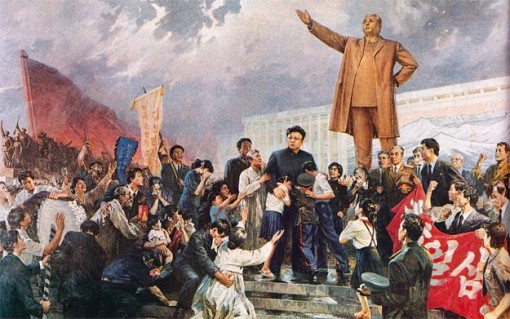

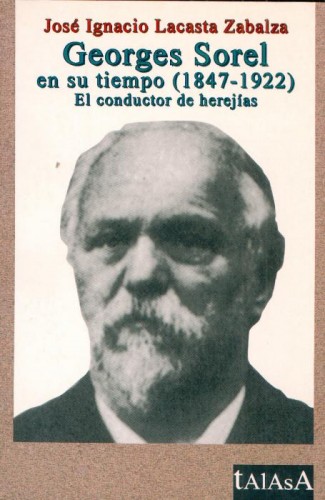
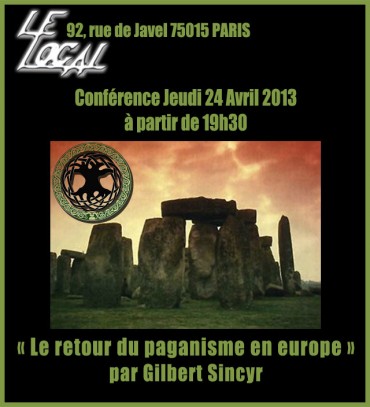



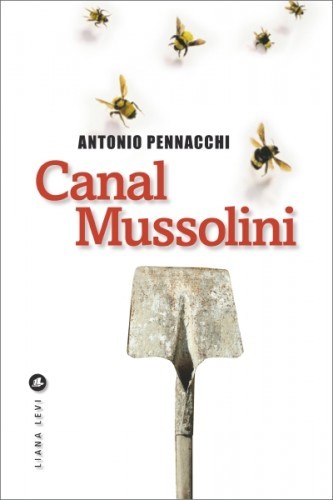 Canale Mussolini ist ein Epochen- und Familienroman, der – autobiographisch angereichert – davon erzählt, wie aus den Männern und Frauen einer norditalienischen, mittellosen Bauernsippe handfeste Faschisten werden: un-ideologische zwar, aber ist das nicht immer so, wenn es um die Masse unterhalb der weltanschaulich gefestigten Revolutionäre geht?
Canale Mussolini ist ein Epochen- und Familienroman, der – autobiographisch angereichert – davon erzählt, wie aus den Männern und Frauen einer norditalienischen, mittellosen Bauernsippe handfeste Faschisten werden: un-ideologische zwar, aber ist das nicht immer so, wenn es um die Masse unterhalb der weltanschaulich gefestigten Revolutionäre geht? Cofundador del Comité d’Action de Défense des Belges à l’Áfrique (CADBA), constituído en julio de 1960, inmediatamente después de las violaciones de Leopoldvlile y de Thysville, de las que fueron víctmas los belgas de Congo y cofundador del Mouvement d’Action Civique que sucedió al CADBA, el belga JeanThiriart, en diciembre de 1960, lanzó la organización Jeune Europe, que durante varios meses será el principal sostén logístico y base de retaguardia de la OAS-Metro.
Cofundador del Comité d’Action de Défense des Belges à l’Áfrique (CADBA), constituído en julio de 1960, inmediatamente después de las violaciones de Leopoldvlile y de Thysville, de las que fueron víctmas los belgas de Congo y cofundador del Mouvement d’Action Civique que sucedió al CADBA, el belga JeanThiriart, en diciembre de 1960, lanzó la organización Jeune Europe, que durante varios meses será el principal sostén logístico y base de retaguardia de la OAS-Metro.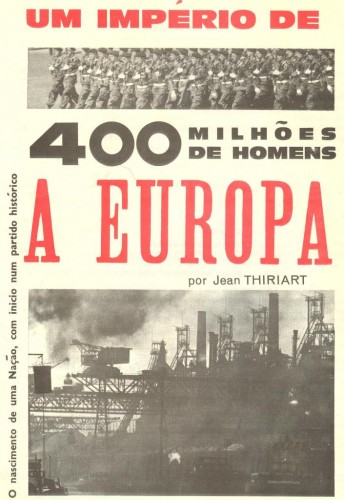
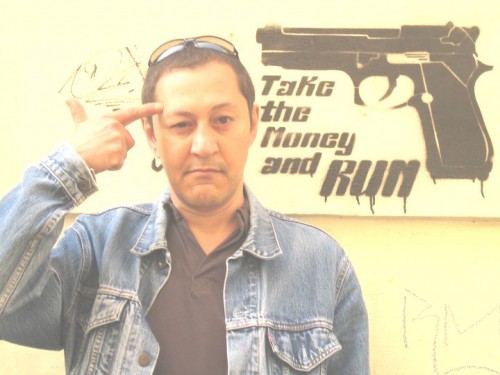
![[Lecture] Contre l’Europe de Bruxelles – Fonder un Etat européen, par Gérard Dussouy](http://fr.novopress.info/wp-content/uploads/2013/04/dussouy_modifie-1.jpg)




